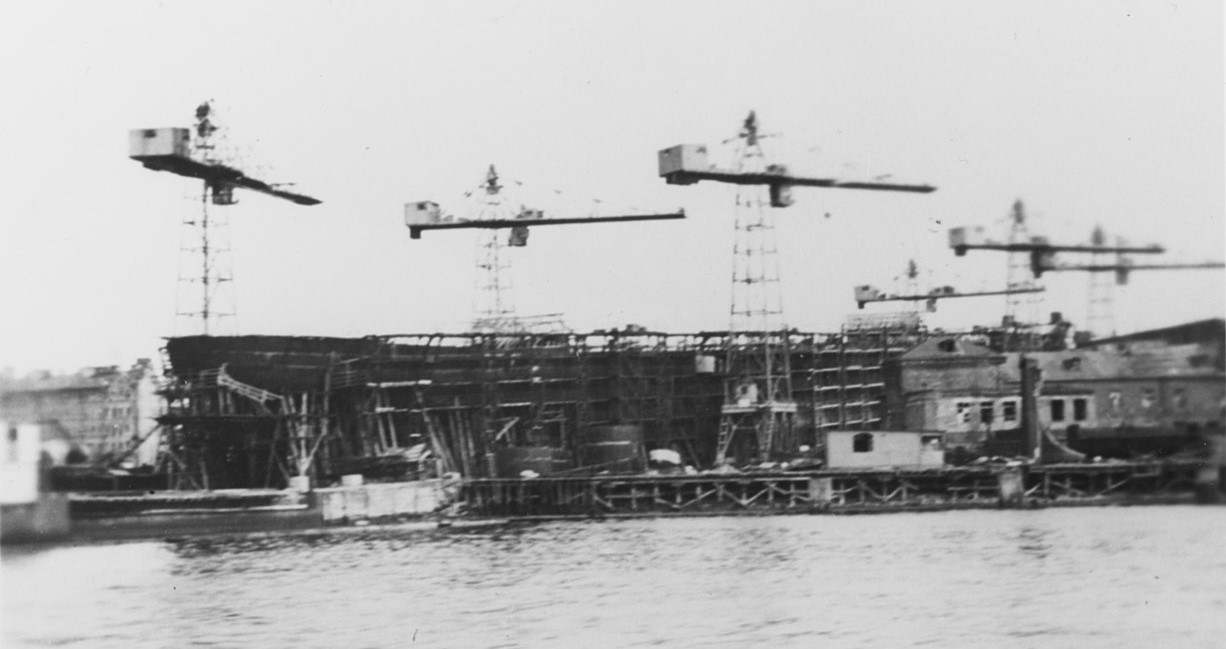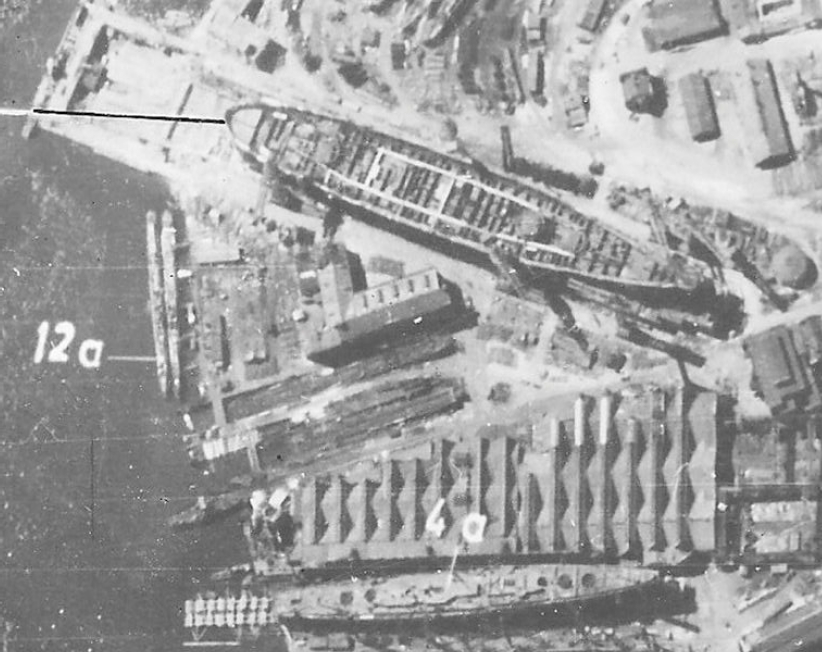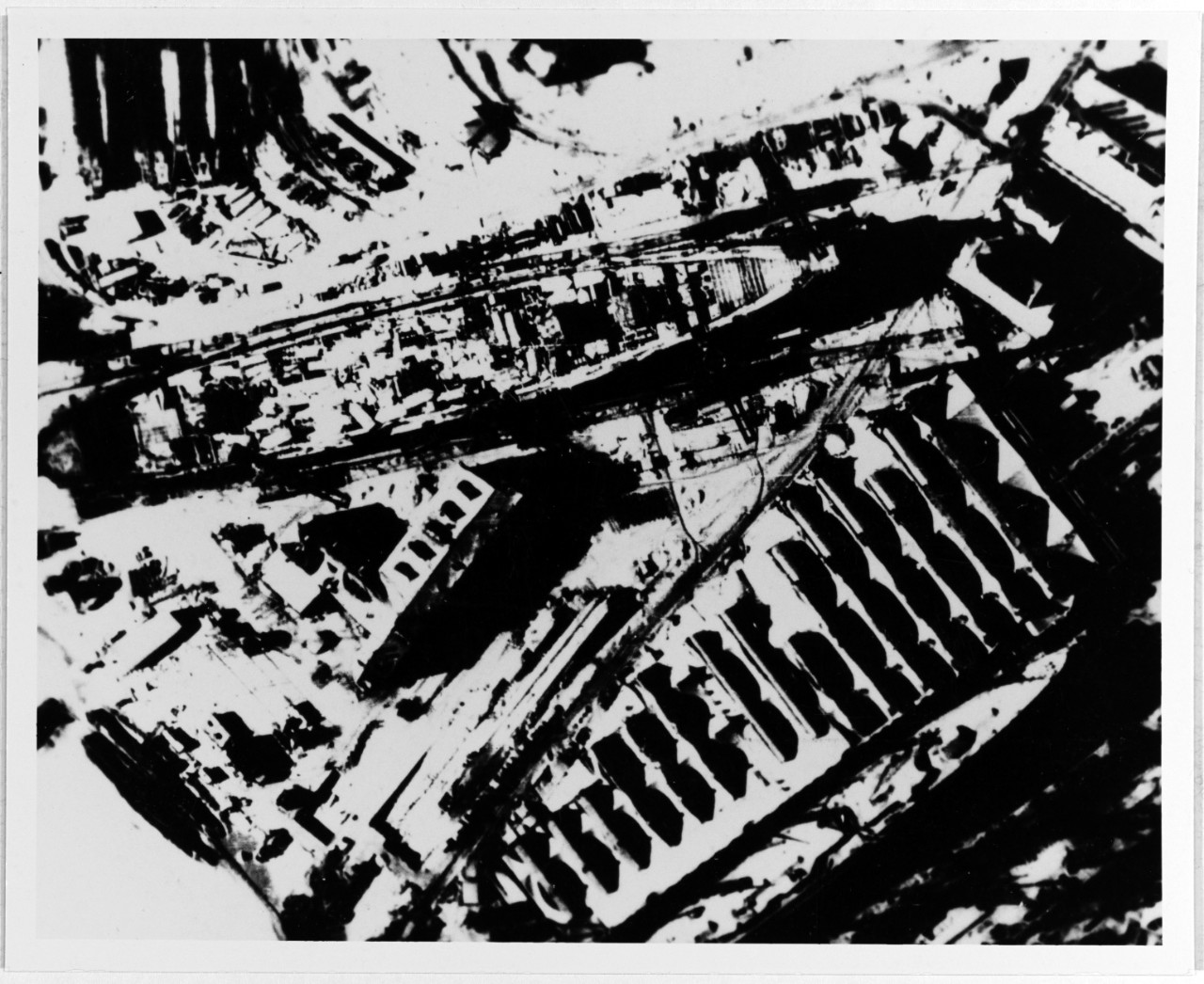It's been quite a while since I looked at the battleships of Russia and the Soviet Union, but it's time I returned to this fascinating and largely-overlooked field. This time, we'll look at the closest the Soviets ever came to actually getting ships into service, the Sovetskii Soiuz class1.

The incomplete hull of Sovetskii Soiuz in 19442
Development of what became the Sovetskii Soiuz began in 1935, as Design A, in parallel with the smaller Design B. The initial designs were absolutely ridiculous, with the largest eclipsing even Yamato in tonnage and armed with 16 450mm (17.7") guns. The design actually selected was very slightly more sensible, with 9 460mm (18.1") guns, 32 130mm secondaries, a 450mm belt and a speed of 36 kts, all on 55,000 tons. Actually, it was no more sensible, with more armor and higher speed than Yamato on a smaller hull. This was soon noticed by the people actually responsible for building the ship, who managed to cut speed to 30 kts and the belt to 420mm, still probably too much for the size of the hull.
Even this wasn't the height of grandiose Soviet battleship designs. Sketches were made of 80,000 ton ships, one armed with 9 500mm (19.7") guns and protected by a belt of the same thickness, and another with six 530mm (20.9") guns. These were soon identified as too big, and they retreated to the 55,000 ton designs, which could actually be built by Soviet industry. This also came to be seen as too large after studies by the Soviet Naval Academy on tactical effectiveness, and by mid-1936, the gun caliber had been fixed at 16" and the tonnage reduced to 45,000, essentially the same specs as the American Iowas.
This was soon too much, as the Soviets signed an agreement with the British in August, limiting them to the terms of the London Naval Treaty, with the same escalator clause that had been put in place in case Japan refused to sign. The Naval Administration wasn't happy with the 35,000 ton limit, and soon got it raised to 41,500 tons, a value that would hopefully not violate the treaty limit too obviously. The characteristics prepared for the sketch designers to work from had 9 406mm guns, a 380mm belt,3 and a speed of 30 kts, with a split secondary battery with a dozen each of 152mm (6") and 100mm guns. Two different design bureaus prepared alternative sketches, but both required approximately 45,000 tons to achieve the desired characteristics. There was significant debate over how to shaft the ships, with three shafts producing a shorter citadel, but giving very high power loading relative to four, a dispute Stalin personally settled in favor of the triple shafts.

A German reconnaissance photograph of Sovetskii Soiuz under construction, just days after their invasion began. Light cruiser Chkalov is at the bottom.
Even this was not enough, and many within the Soviet naval establishment pushed for much bigger designs, around 55,000 tons. In July 1937, they won Stalin over, and the existing design was thrown out in favor of a bigger one. Any hope of completing the revised design quickly was dashed by the Great Purge, which struck the Navy even as the new design was being approved. A few naval architects survived, and managed to produce something approaching a final design by February 1938, although details including the machinery layout and secondary armament mounts remained vague. Extensive test work was carried out to determine the best options for things like deck and underwater protection. Full-size mockups of American-style multibulkhead and the Italian Puligese torpedo defense systems were constructed, although the trials weren't carried out until the fall of 1939, too late to discard the inferior Italian system from the design.
There were other detail design problems that had to be corrected even as metal was being prepared for the new ships. Tests of the triple rudder showed that the wing rudders would not be able to counteract a jammed center rudder, so it was deleted, with a loss of maneuverability. The design continued to grow, reaching an official standard displacement of 59,150 tons, although the actual figure, had the ships been completed, would have likely been around 60,000 standard and 67,000 full load.
In January 1938, the Soviets announced that four battleships would be laid down immediately, launched in 1939 and commissioned two years later. This was an absurd figure for a country that hadn't built a battleship in over 20 years, and the official keel-laying of the lead ship, Sovetskii Soiuz, in July 1938, was merely to placate Stalin, with actual work beginning in January 1939 at the Ordzhonikidze Yard near Leningrad. A second ship, Sovetskaia Ukraina, was laid down at Nikolaev on the Black Sea, while two more, Sovetskaia Belorussiia and Sovetskaia Rossiia, were to be built at a new shipyard in Molotovsk, near Archangel, although most of the components were being shipped in from Leningrad.
Construction didn't go smoothly, combining the traditional problems of Russian battleship construction with new ones invented by the Soviets. In 1939, plans called for 10,000 tons of armor, but deliveries totaled only 1,800 tons, and over half was rejected as failing quality control. Problems with production of cemented armor saw the replacement of such plates with simpler face-hardened plates anywhere over 200mm thick. To help compensate for the loss of the cemented layer, the Soviets made the whole plate harder, and thus brittle, greatly reducing protection. Some turbines had been ordered from Switzerland, but attempts to produce more domestically failed completely, and propeller shafting had to be imported because domestic plants were overloaded. Only half the required men were available to the shipyards, and by August 1939, the estimated launch dates for the two ships at established shipyards was mid-1941, with completion about two years later. In mid-1940, it was discovered that 70,000 rivets in the bottom of Sovetskaia Belorussiia were made from inferior steel, and the ship was suspended, then cancelled on October 19th to free resources for the other three ships.

A later recon photo of Sovetskii Soiuz in the Baltic Yard, March 1942
Even this wasn't enough, and by the time the Germans invaded in June 1941, the launch date for the two lead ships was still two years away, and Sovetskii Soiuz was only 20% complete, with Sovetskaia Ukraina at 18% and Sovetskaia Rossiia at only 5%. All three ships were immediately suspended, and Sovetskaia Ukraina's hull fell into German hands when they captured the Crimea despite Soviet attempts to evacuate it, and the Nazis disassembled parts of the hull to help fortify their captures. Before they withdrew in 1944, they removed some of the blocks under the hull, essentially writing it off. The other two ships survived the war with surprisingly little damage, but were cancelled postwar and scrapped.
The design itself was fairly conventional, if rather larger than any other nation would have required for the amount of firepower it had. The 406mm/50 guns were about the only things that were actually ready on time, with a dozen guns completed by the time of the invasion, and one that had been fully tested. It was used in the defense of Leningrad, and survives to this day. The fire control system was also conventional, and is primarily of interest because the director had two rangefinders, one to range on the target, the other for the shell splashes. The 152mm weapons were concentrated amidships due to fear of muzzle blast. The light AA battery was built around 8 quad 37mm mounts. Unusually, these were enclosed, probably also for blast protection. Two catapults were fitted, and four flying boats were planned, although it's likely that two would have been deleted to clear arcs for the 100mm guns. The very full hull form, adopted to ensure adequate protection of the magazines, meant that the ship required 201,000 shp to reach a relatively moderate speed of 27.5 kts. Forced draft could have boosted this to 231,000 shp, more than the Iowas had, at a gain of a single knot.
So what are we to make of the Sovetskii Soiuz class? On the whole, it was not a good design. The Soviets tried to create a competitive battleship without the technology or industrial base to do so. The result was a ship the size of the Yamato that in practice would have been inferior to most of the treaty battleships in overall performance. The situation was made worse by the lack of design discipline. Instead of getting clever, like the Americans did with the South Dakota class, the Soviet designers merely convinced Stalin to authorize bigger ships. The design was compromised even more by the wider situation in the USSR, which lead to the only case I'm aware of of a battleship being cancelled due to quality-control problems, and to serious delays in the other three ships. Even without the German invasion, the ships would have been completed alongside vessels like the Montana and Lion classes, which would have greatly outmatched them. And all of this completely ignores the fact that the ships were built without a solid rationale. Instead, they were a vanity project for Stalin. And as you'd expect for ships designed under these circumstances, they were lacking on many levels. But even the failure of these ships wasn't enough to deter Stalin, and he would try again after WWII. We'll look at that next time.
1 Note that I'm following Stephen McLaughlin's transliterations in this series, and not the more common version, which reads Sovetsky Soyuz. ⇑
2 I apologize for the lack of diagrams/pictures of the ships as they would look when completed, but there are no public-domain images of such a vessel, and the task completely swamps my meager art skills. They can be found using google. ⇑
3 The Soviets made use of very heavy belts throughout the design process, probably due to the stagnation of their heavy armor industry in the interwar years. They were essentially having to equip their ships with WWI-era armor, which did a great deal to drive up size. As it was, the completed design had slightly more tonnage in armor than the Yamato did, although more of it was outside the citadel, and the armor itself was inferior. ⇑

Comments
The world's first test of "so you want to build a battleship"?
Sort of a glimpse at the chain of institutional memory required all the way down from the designer to the guy making metal for the rivets.